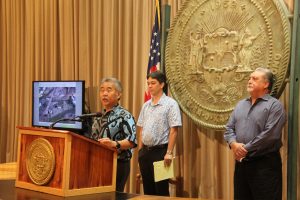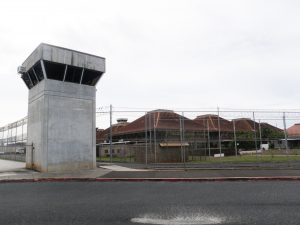Why the push for jail improvements statewide? Because current conditions and calls for criminal justice reform are making this an issue the community can no longer ignore, say state officials. Antiquated buildings with outdated technology pose serious risks of overcrowding, safety, and security for inmates, staff and the community alike. This is true for both prisons and jails, where conditions such as those at the O‘ahu Community Correctional Center (OCCC), Hawai‘i’s largest jail, can lead to crises that could be prevented.
For decades, Hawai‘i’s officials have discussed “right-sizing” jails across the state to better serve the needs of those incarcerated. Now, the Ige administration has made major progress toward this goal. The governor recently accepted the final environmental impact statement (EIS) to relocate OCCC from its current Kalihi location to the Animal Quarantine Station site in Halawa Valley. The EIS also envisions an expanded Women’s Community Correctional Center in Kailua to accommodate female inmates currently housed at OCCC.

Gov. Ige describes the need to replace OCCC at a press conference with Rod Becker (left), director of the Department of Accounting and General Services and Nolan Espinda, director of the Department of Public Safety.
“Building a new OCCC facility is one of my top priorities,” said Governor Ige at an August news conference announcing acceptance of the EIS. “It’s also an opportunity to reposition Kalihi for a new economic development future, with job creation, affordable housing, and open spaces, creating an invigorated livable, walkable community.” Department of Public Safety (PSD) director Nolan Espinda explained, “The current OCCC is drastically outdated and overcrowded. The 40-year-old jail now houses more than 1,200 inmates in facilities originally designed for 628 inmates and modified over the years to house 954. OCCC no longer meets PSD and community needs. The severe overcrowding places the state under a cloud of liability that could threaten autonomous control and supervision of OCCC and other jails throughout the state. We cannot wait any longer.”
OCCC is an aging facility dating back to the 1950s with a current population of 1,222. The new facility, projected for completion in 2023, would include 1,044 detention beds and 291 beds for those transitioning to life back in the community, including work furlough participants. Governor Ige and PSD director Espinda have pointed to the challenge faced by the state’s executive branch in having no say on the legal outcome for offenders because the size of the jail population depends on the courts’ adjudication of crimes, which includes pretrial detainees. “Clearly, we see an avenue through judicial reform to right-size the state’s jail population,” said the governor. “What the new facility is trying to find is a balance between incarcerating those who have violated the law, those who are awaiting trial, and those transitioning back to the community to become contributing members of society.”

At the Women’s Community Correctional Center, graduates and teachers of the Intermediate Culinary Class, one of the skills training programs.
Espinda acknowledged community efforts aimed at criminal justice reform and reduction of jail and prison populations. “We’re looking at different tactics and strategies employed by the courts and treatment programs for drug and alcohol addiction, he said.” Espinda referred to task force reports due at the end of this year to address issues of overcrowding and rehabilitation. “We want to keep costs down, be culturally sensitive, and focus on ‘best practices’ being used successfully nationwide,” he added. Governor Ige said the state will be working to arrive at the best community solution. “Public Safety is an active participant in both the HCR 85 (2016, amended in 2017) and HCR 134 (2017) Task Forces. PSD and this administration will apply full consideration to the recommendations made in the task forces’ final reports and will work closely with both the task forces and the Legislature as we plan for a new OCCC facility,” he said.
The stakes are high, considering that 95 percent of inmates will be released back to their communities. Without effective programs while incarcerated, inmates are more likely to reoffend and return to prison. Said Espinda, “We need adequate space to provide for rehabilitation so inmates can learn to provide for themselves as they transition back to their communities. This is why replacing OCCC with a modern facility has been a goal of the department for over a decade.”
He added that plans are “well underway” to address overcrowding in jails on Maui, Kaua‘i, and Hawai‘i island with funding already provided by the Legislature. Plans call for adding bed space to each of the neighbor island jails. Construction for new Hawai‘i Community Correctional Center and Kaua‘i Community Correctional Center housing is expected to start in October 2019, with completion by November 2020. Construction of additional Maui Community Correctional Center bed space is expected to begin in December 2019 with completion by January 2021.
Governor Ige said the state will be looking at different options to finance construction of the new OCCC, including general obligation bonds and a public-private partnership. And, what about those who say the money would be better spent preventing incarceration? “Certainly, the design and size of a new facility will take into account best practices, but adjudication and sentencing are driven by the justice system,” said the governor. “Our responsibility on the executive branch side is to have a humane place where people can receive needed services during their incarceration.” To learn more about the future of OCCC, visit DPS.Hawaii.gov/OCCC-future-plans.
What is the difference between a jail like OCCC and a prison like Halawa Correctional Facility?
- Jails house 1) pretrial detainees, 2) inmates in their final year of incarceration and transitioning to the community through the furlough program, and 3) those with sentences of less than a year.
- Prisons house those serving extended sentences.
Read more in November’s Capitol Connection newsletter
Subscribe to Capitol Connection
